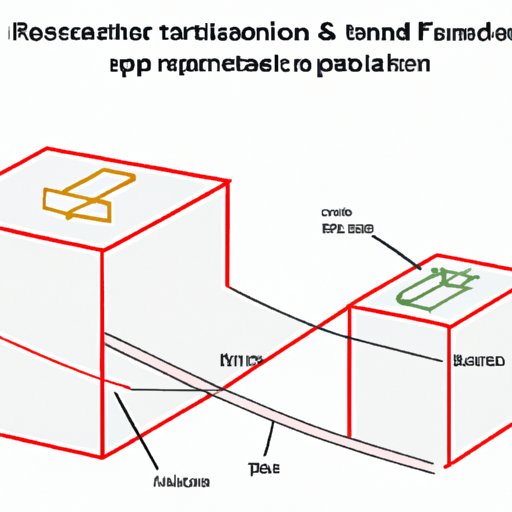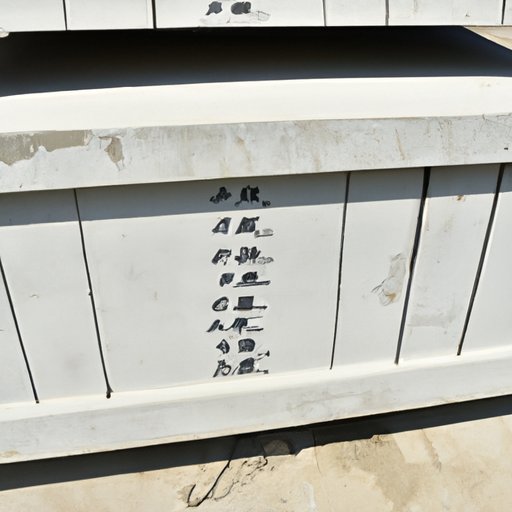I. Introduction
Have you ever been asked to convert a volume measurement from cubic feet to cubic yards or vice versa? This can be a daunting task for anyone who is not familiar with the relationship between the two measurements. Understanding how many cubic feet are in a cubic yard is not only important for everyday tasks, but can also be crucial in various industries such as construction and landscaping. This article provides a comprehensive guide to understanding the relationship between cubic feet and cubic yards and how to convert them.

II. Understanding Measurements: The Relationship Between Cubic Feet and Cubic Yards
Cubic feet and cubic yards are both units of volume that are commonly used in various situations. A cubic foot is a volume measurement that represents the amount of space that is contained in a cube that is one foot wide, one foot long, and one foot tall. A cubic yard, on the other hand, represents the amount of space that is contained in a cube that is three feet wide, three feet long, and three feet tall.
While both measurements are used to describe volume, cubic yards are much larger than cubic feet. In fact, there are 27 cubic feet in a cubic yard. Understanding the relationship between cubic feet and cubic yards is important because it can help you accurately calculate volume and avoid costly mistakes.
III. From Small to Big: Converting Cubic Feet to Cubic Yards
When converting cubic feet to cubic yards, you must understand the conversion factor. As mentioned earlier, there are 27 cubic feet in a cubic yard. To convert cubic feet to cubic yards, you simply divide the number of cubic feet by 27.
For example, let’s say you have a pile of dirt that measures 81 cubic feet. To convert this to cubic yards, you would simply divide 81 by 27: 81/27 = 3 cubic yards.
Understanding the conversion factor is important because it can help you estimate the amount of material you need when working on a project. For example, if you know the volume of a space in cubic feet, you can easily convert it to cubic yards to order the appropriate amount of material.
IV. A Comprehensive Guide to Calculating Cubic Feet in a Cubic Yard
Calculating the number of cubic feet in a cubic yard can be done by using a simple formula. The formula for calculating cubic feet in a cubic yard is:
cubic feet = cubic yards x 27
Using this formula, you can calculate any volume measurement in cubic yards that you need to convert to cubic feet.
Let’s say you have a swimming pool that measures 10 cubic yards and you want to know how many cubic feet of water it can hold. Using the formula above, you would multiply 10 cubic yards by 27 cubic feet per cubic yard: 10 cubic yards x 27 cubic feet per cubic yard = 270 cubic feet. So, your swimming pool can hold up to 270 cubic feet of water.
It is important to be precise in your calculations, especially when working with large volumes of materials. A slight miscalculation can lead to costly mistakes, so take the time to carefully calculate your measurements.
V. Cubic Feet vs Cubic Yards: How to Convert and Use the Measurements
Knowing when to use cubic feet or cubic yards is important when working on projects that require volume measurements. Cubic feet are commonly used to measure smaller volumes, such as the interior space of a refrigerator or the size of a small garden bed. Cubic yards, on the other hand, are used for larger volumes, such as the amount of dirt needed to fill a large hole or the volume of concrete needed for a foundation.
To convert between the two measurements, you simply need to use the conversion factor of 27 cubic feet per cubic yard or divide the number of cubic feet by 27 to get cubic yards.
It is important to use the correct measurement for your project to avoid over or underestimating the amount of material you need. Using the wrong measurement can lead to costly mistakes and waste materials, time, and money.
VI. The Simple Science of Cubic Feet in a Cubic Yard
The relationship between cubic feet and cubic yards is simple and based on the concept of volume. Different industries use these measurements for various applications, including construction, landscaping, and interior design. When ordering materials, it is important to understand the volume of the space you are working with and how much material you will need. By understanding the science behind the measurements, you can accurately calculate the amount of material required for your project and save time and money in the process.
VII. Unlocking the Mystery of Cubic Feet and Yards: A Step-by-Step Guide
To use cubic feet and cubic yards in your calculations, follow these simple steps:
- Determine the volume of the space in cubic feet
- Convert the volume of the space from cubic feet to cubic yards using the conversion factor of 27 cubic feet per cubic yard
- Use the appropriate measurement to order materials
When calculating measurements, it is important to simplify the process by rounding numbers and using tools like calculators and spreadsheets. With practice and patience, you can master the art of volume measurements and use your newfound knowledge in various projects.
VIII. How to Avoid Costly Errors: Converting Cubic Feet to Cubic Yards Made Easy
When converting cubic feet to cubic yards, there are common errors that can occur. These errors include:
- Forgetting to divide by 27 when converting cubic feet to cubic yards
- Using the wrong measurement for your project
- Miscalculating the volume of the space you are measuring
To avoid these errors, be sure to double-check your calculations and use the appropriate measurement for your project. Always use accurate measurements to avoid wasting materials and time.
IX. Conclusion
Understanding the relationship between cubic feet and cubic yards is crucial for accurate volume calculations in various industries. By using the conversion factor of 27 cubic feet per cubic yard, you can easily convert between the two measurements. Remember to use the appropriate measurement for your project to avoid errors and unnecessary waste. With practice and patience, you can become proficient at volume measurements and apply your learnings in real-world situations.
